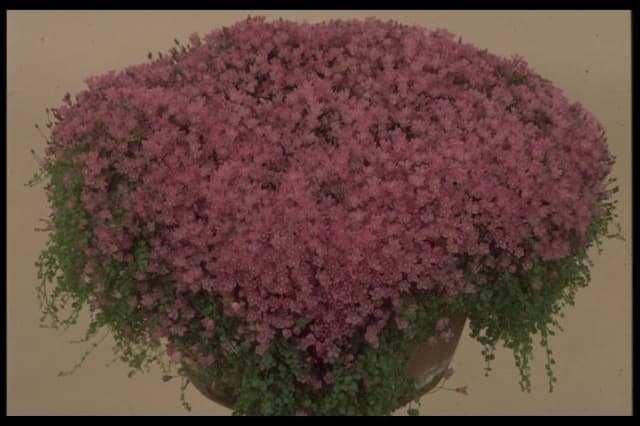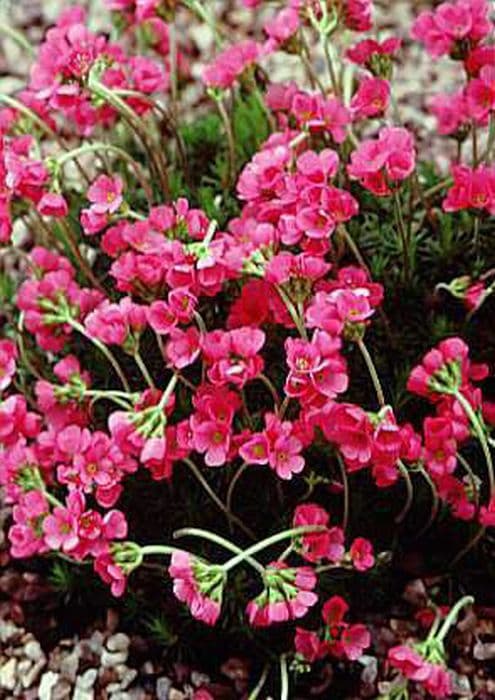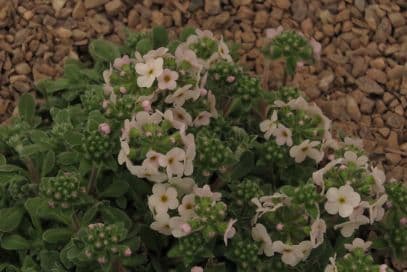Auricula 'Taffeta' Primula auricula 'Taffeta' (Au/s)

ABOUT
'Taffeta' is an evergreen, perennial, self-coloured, show auricula up to 20cm tall, with rosettes of grey-green leaves. Clusters of dark pink flowers with white centres and yellow-green eyes are produced on short stems in spring
About this plant
 Names
NamesFamily
Primulaceae
Synonyms
Bear's Ear, Mountain Cowslip, Auricula
Common names
Primula auricula 'Taffeta' (Au/s).
 Characteristics
CharacteristicsLife cycle
Perennials
Foliage type
Evergreen
Color of leaves
Green
Flower color
Mixed
Height
6 inches (15 cm)
Spread
6 inches (15 cm)
Plant type
Herb
Hardiness zones
5
Native area
Europe
Benefits
 General Benefits
General Benefits- Aesthetic Appeal: Adds vibrant color to gardens with its unique and striking flowers.
- Low Maintenance: Requires minimal care once established, making it ideal for busy gardeners.
- Drought Tolerance: Capable of surviving dry periods, reducing the need for frequent watering.
- Cold Hardy: Well-suited to cooler climates and can survive frost, extending its growing season in temperate regions.
- Attracts Pollinators: Flowers are known to attract bees and butterflies, which help in the pollination of surrounding plants.
- Compact Growth: Its small size allows it to fit well in rockeries, containers, and small garden spaces.
- Long Blooming Period: Provides color throughout spring and into early summer, enriching the garden for an extended time.
- Easy to Propagate: Can be easily propagated from offsets or seed, allowing gardeners to increase their stock or share with others.
- Versatile Display Options: Suitable for alpine houses, greenhouse cultivation, and outdoor beds, offering a range of display possibilities.
 Medical Properties
Medical Properties- This plant is not used for medical purposes.
 Air-purifying Qualities
Air-purifying QualitiesThis plant is not specifically known for air purifying qualities.
 Other Uses
Other Uses- The bear's ear can be employed in alpine rock gardens for its unique appearance and ability to grow in gravelly, well-drained soil.
- This plant, with its attractive foliage and vibrant flowers, is often used in container gardening, adding elegance and color to patios and balconies.
- Bear's ear blossoms can be crystallized and used to decorate desserts and cakes, creating an enchanting and edible garnish.
- They can be used in corsages and small, delicate floral arrangements owing to their compact size and striking colors.
- The leaves of the plant, which are often ornately patterned, can be used in pressed flower crafts or botanical prints for artistic projects.
- In mild climates, bear's ear can serve as a ground cover plant due to its ability to form dense clumps.
- Their striking appearance can be employed in photography, particularly macro photography, to create visually appealing images celebrating the patterns and textures of nature.
- Bear's ear can be incorporated into educational programs in schools and botanical gardens to teach about plant diversity and Alpine flora.
- Can be used in theatre or movie sets as natural decoration to create an authentic-looking alpine environment.
- They may be cultivated for flower shows and competitions, where enthusiasts can display exceptional specimens for judging and awards.
Interesting Facts
 Feng Shui
Feng ShuiThe Primula is not used in Feng Shui practice.
 Zodiac Sign Compitability
Zodiac Sign CompitabilityThe Primula is not used in astrology practice.
 Plant Symbolism
Plant Symbolism- Rarity: As Primula auricula 'Taffeta' is a specific cultivar, it symbolizes uniqueness and rarity, suggesting that the person or situation it represents is one-of-a-kind.
- Diligence: Auriculas are known for their need for careful cultivation, representing hard work and the rewards that come from meticulous attention.
- Preciousness: With its striking appearance, the auricula is often seen as a symbol of something that is highly prized or of great value.
- Pride: In the language of flowers, the auricula can symbolize pride due to its showy, attention-grabbing blossoms, representing pride in oneself or accomplishments.
- Boldness: The vibrant and diverse colors of Primula auricula imply confidence and the willingness to stand out or take risks.
 Water
WaterThe Bear's Ear should be watered regularly, keeping the soil slightly moist but not soggy. It is typically best to water this plant once every week with about 16 ounces of water. During the active growing season, in spring and summer, you might need to increase the frequency to twice a week depending on the temperature and humidity. In the winter months, reduce watering to every other week as the plant enters a dormancy period. Always check the top inch of soil for dryness before watering to avoid overwatering, which can lead to root rot.
 Light
LightBear’s Ear prefers bright, indirect sunlight. It should be placed in a spot where it will receive light but be shielded from the intense direct rays of the sun, making a north-facing or east-facing window ideal. Too much direct sunlight can scorch the leaves, while too little light may cause the plant to become leggy and reduce flowering.
 Temperature
TemperatureBear's Ear thrives best in cool temperatures between 50 and 60 degrees Fahrenheit but can tolerate a range from 40 to 80 degrees Fahrenheit. Avoid placing the plant near heat sources or in locations with drastic temperature changes. The ideal temperature will encourage lush foliage growth and optimal flowering.
 Pruning
PruningPruning Bear's Ear is essential for removing dead or fading flowers to promote new blooms and maintain a tidy appearance. Pruning should be done immediately after the plant finishes flowering, typically in late spring or early summer. Gently pinch off spent flowers and any damaged or yellowing leaves. Regular pruning also helps to prevent disease by improving air circulation around the plant.
 Cleaning
CleaningAs needed
 Soil
SoilAuricula Primrose 'Taffeta' thrives best in a well-draining soil mix comprising one part loam, one part peat-free compost, and one part leaf mold or grit, with a preferred pH range of 6.0 to 7.5.
 Repotting
RepottingAuricula Primrose 'Taffeta' should be repotted every year or two, ideally in late summer after flowering or in early fall to ensure healthy growth and blooming.
 Humidity & Misting
Humidity & MistingAuricula Primrose 'Taffeta' prefers moderate humidity levels, around 50-60%, avoiding excess moisture which can lead to fungal diseases.
 Suitable locations
Suitable locationsIndoor
Place in bright, indirect light with cool temps.
Outdoor
Plant in partial shade; protect from harsh elements.
Hardiness zone
4-8 USDA
 Life cycle
Life cyclePrimula auricula 'Taffeta', commonly known as Auricula, begins its life as a seed sown in well-drained, moist soil, typically in late winter or early spring. Upon germination, which may take a few weeks, the seedlings emerge, developing into rosettes of green, sometimes farinose (mealy) leaves. As the plant matures during the spring, flower stalks arise from the center of the rosette, bearing clusters of showy, often fragrant flowers in a wide range of colors, from deeply saturated to pastel hues, often with a contrasting central eye. After flowering, which occurs in mid to late spring, the plant sets seed, completing the reproductive cycle; the seeds can be collected for propagation or left to self-sow. Throughout the summer, the Auricula continues to grow vegetatively, with some plants producing offsets that can be divided and replanted to propagate new individuals. As a perennial, the Auricula retreats into dormancy in autumn and winter, withdrawing energy into its roots to survive cold temperatures, resuming growth when conditions become favorable in the following spring.
 Propogation
PropogationPropogation time
Spring to Summer
Propogation: Primula auricula 'Taffeta', commonly known as Auricula Primrose, is generally propagated by division. The best time to divide the plant is in the early spring or late summer after the flowering period has ended. To propagate by division, carefully lift the plant from the ground and gently separate the offsets from the parent plant with your hands or a sharp knife. Each offset should have a portion of the root attached. Replant the divided sections at the same depth they were growing at before and water well. This method encourages healthy growth and rejuvenates older clumps, ensuring the longevity and vigor of the Auricula Primrose in the garden.









